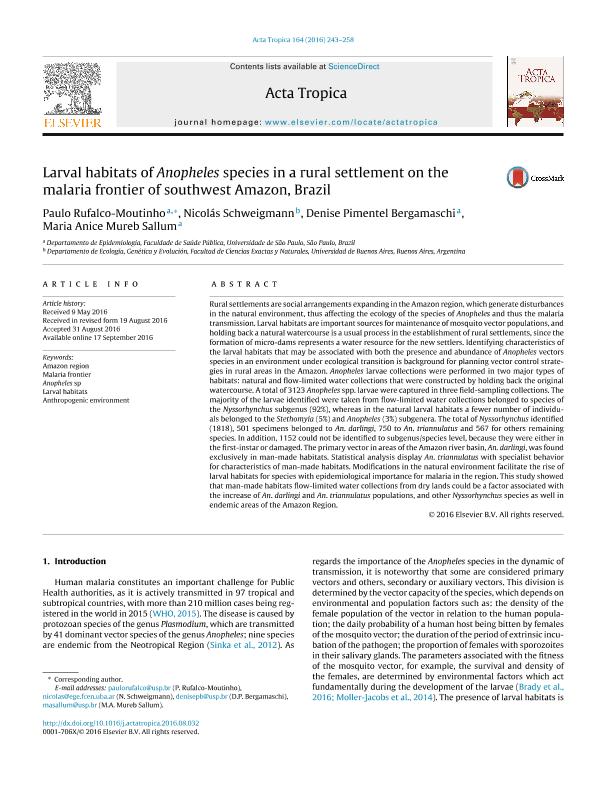Artículo
Larval habitats of Anopheles species in a rural settlement on the malaria frontier of southwest Amazon, Brazil
Rufalco-Moutinho, Paulo; Schweigmann, Nicolas Joaquin ; Bergamaschi, Denise Pimentel; Mureb Sallum, Maria Anice
; Bergamaschi, Denise Pimentel; Mureb Sallum, Maria Anice
 ; Bergamaschi, Denise Pimentel; Mureb Sallum, Maria Anice
; Bergamaschi, Denise Pimentel; Mureb Sallum, Maria Anice
Fecha de publicación:
12/2016
Editorial:
Elsevier Science
Revista:
Acta Tropica
ISSN:
0001-706X
Idioma:
Inglés
Tipo de recurso:
Artículo publicado
Clasificación temática:
Resumen
Rural settlements are social arrangements expanding in the Amazon region, which generate disturbances in the natural environment, thus affecting the ecology of the species of Anopheles and thus the malaria transmission. Larval habitats are important sources for maintenance of mosquito vector populations, and holding back a natural watercourse is a usual process in the establishment of rural settlements, since the formation of micro-dams represents a water resource for the new settlers. Identifying characteristics of the larval habitats that may be associated with both the presence and abundance of Anopheles vectors species in an environment under ecological transition is background for planning vector control strategies in rural areas in the Amazon. Anopheles larvae collections were performed in two major types of habitats: natural and flow-limited water collections that were constructed by holding back the original watercourse. A total of 3123 Anopheles spp. larvae were captured in three field-sampling collections. The majority of the larvae identified were taken from flow-limited water collections belonged to species of the Nyssorhynchus subgenus (92%), whereas in the natural larval habitats a fewer number of individuals belonged to the Stethomyia (5%) and Anopheles (3%) subgenera. The total of Nyssorhynchus identified (1818), 501 specimens belonged to An. darlingi, 750 to An. triannulatus and 567 for others remaining species. In addition, 1152 could not be identified to subgenus/species level, because they were either in the first-instar or damaged. The primary vector in areas of the Amazon river basin, An. darlingi, was found exclusively in man-made habitats. Statistical analysis display An. triannulatus with specialist behavior for characteristics of man-made habitats. Modifications in the natural environment facilitate the rise of larval habitats for species with epidemiological importance for malaria in the region. This study showed that man-made habitats flow-limited water collections from dry lands could be a factor associated with the increase of An. darlingi and An. triannulatus populations, and other Nyssorhynchus species as well in endemic areas of the Amazon Region.
Archivos asociados
Licencia
Identificadores
Colecciones
Articulos(IEGEBA)
Articulos de INSTITUTO DE ECOLOGIA, GENETICA Y EVOLUCION DE BS. AS
Articulos de INSTITUTO DE ECOLOGIA, GENETICA Y EVOLUCION DE BS. AS
Citación
Rufalco-Moutinho, Paulo; Schweigmann, Nicolas Joaquin; Bergamaschi, Denise Pimentel; Mureb Sallum, Maria Anice; Larval habitats of Anopheles species in a rural settlement on the malaria frontier of southwest Amazon, Brazil; Elsevier Science; Acta Tropica; 164; 12-2016; 243-258
Compartir
Altmétricas



